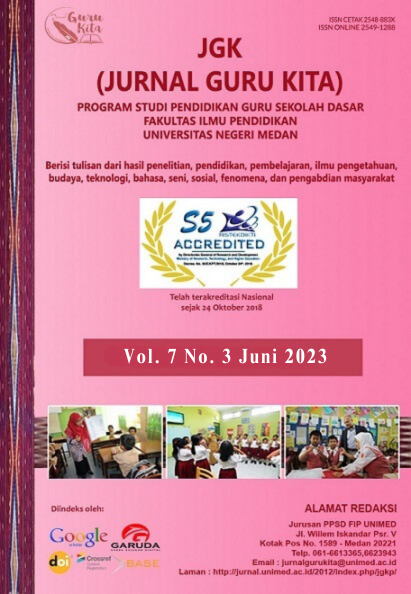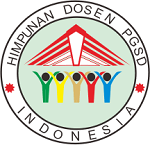PERBEDAAN HASIL BELAJAR DAN MINAT SISWA MENGGUNAKAN MEDIA MACROMEDIA FLASH DAN MEDIA POWTOON PADA MATERI LARUTAN ELEKTROLIT DAN NON-ELEKTROLIT
DOI:
https://doi.org/10.24114/jgk.v7i3.44724Abstract
This study aims to identify differences in learning outcomes and interests of students who are taught using Macromedia Flash and Powtoon media for electrolyte and non-electrolyte solutions. The population of this study were all students of class X MIPA, totaling 3 classes. Sampling was done by purposive sampling. Data on student learning outcomes were examined for validity, difficulty, discriminating power, and reliability using an objective test instrument consisting of 20 questions. To measure student interest, the data used a questionnaire filled in by the observer. Pretest, posttest, and students' interest in the two experimental classes were determined based on normality test data and homogeneity test. In the Experimental Class I and Experimental Class II, it was found that the pretest, posttest, and students' interest in the two experimental classes were normally distributed and homogeneous. Next, a hypothesis test was carried out using a two-party Independent Sample T-Test. To test the first hypothesis, the results were sig. 0.024 (sig. <0.05) and to test the hypothesis II, the results were sig. 0.000 (sig. <0.05), which means that there is a significant difference in the learning outcomes and interests of students taught with Macromedia Flash Media using the Problem Based Learning model compared to the learning outcomes and interests of students taught with Powtoon Media using the Problem Based Learning model in the material electrolyte and non-electrolyte solutions.References
Andriani, F. P., & Wahjudi, E. (2018). Analisis Perbandingan Hasil Belajar Menggunakan Powerpoint Dan Powtoon Berbasis Problem Based Learning (PBL) Pada Mata Pelajaran Administrasi Pajak Kelas XI SMK Negeri Mojoagung. Jurnal Pendidikan Akuntansi (JPAK), 6(3).
Kemdikbud. (2013). Materi Pelatihan Guru Implementasi Kurikulum 2013 Mata Pelajaran SMA/MA IPA. Jakarta: Kemdikbud.
Latifah, N., & Lazulva, L. (2020). Desain dan uji coba media pembelajaran berbasis video animasi powtoon sebagai sumber belajar pada materi sistem periodik unsur. JEDCHEM (Journal Education and Chemistry), 2(1), 26-31.
Nainggolan, B., & Mutiah, R. (2020). Pengajaran Materi kesetimbangan kimia menggunakan pembelajaran problem based learning disertai macromedia flash hasil pengembangan. Jurnal Inovasi Pembelajaran Kimia (Journal Of Innovation in Chemistry Education), 2(2), 71-80.
Ristiyani, E., & Bahriah, E. S. (2016). Analisis kesulitan belajar kimia siswa di SMAN X Kota Tangerang Selatan. Jurnal Penelitian dan Pembelajaran IPA, 2(1), 18-29.
Saragi, L., & Dalimunthe, M. (2022). Pengaruh model pembelajaran problem based learning dengan menggunakan powerpoint terhadap hasil dan minat belajar siswa pada materi laju reaksi di kelas XI SMA. Jurnal Ilmiah Pendidikan, 1(4), 353“361.
Sihombing, I. S., & Sitorus, M. (2022). Pengembangan E-Modul Kimia Berbasis Proyek pada Materi Larutan Elektrolit dan Non Elektrolit. Jurnal Ilmiah Pendidikan, 1(4), 306“315.
Siregar, S. L., & Panggabean, F. T. M. (2020). Analisis PBL Dengan DL Menggunakan Macromedia Flash Terhadap Motivasi Dan Hasil Belajar Siswa Pada Materi Laju Reaksi Di SMA Negeri 10 Medan. Jurnal Inovasi Pembelajaran Kimia (Journal Of Innovation in Chemistry Education), 2(1), 21-25.
Walisda, M. A., Rahman., & Atmowardoyo, H., (2015). The use of Macromedia Flash Animation to Enhance Student™s English Writing Skill At The Seventh Grade of SMP Yapis 1 Fakfak“West Papua. ELT Worldwide, 2(2):46-63.
Wirasasmita, H. R., & Y. K. Putra. 2015. Pengembangan Media pembelajaraan video tutorial interaktif menggunakan aplikasi camtasia studio dan macromedia flash. Jurnal Education. 10(2), 262-279.
Downloads
Published
How to Cite
Issue
Section
License
Authors published with the JGK (Jurnal Guru Kita) agree to the following terms:
- Authors retain copyright and grant the journal the right of first publication with the work simultaneously licensed under a Creative Commons Attribution License (CC BY-SA 4.0) that allows others to share the work with an acknowledgment of the work's authorship and initial publication in this journal.
- Authors are able to enter into separate, additional contractual arrangements for the non-exclusive distribution of the journal's published version of the work (e.g., post it to an institutional repository or publish it in a book), with an acknowledgment of its initial publication in this journal.
- Authors are permitted and encouraged to post their work online (e.g., in institutional repositories or on their website) prior to and during the submission process, as it can lead to productive exchanges, as well as earlier and greater citation of published work. (See The Effect of Open Access)




























